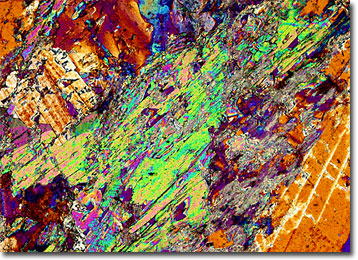Polarized Light Microscopy Digital Image Gallery
Nepheline
Nepheline is the most common of a group of minerals called feldspathoids, which are chemically similar to feldspars but contain less silica. Presence of nepheline is generally an indication that the rock in which it is contained is alkali-rich.

Typically white, gray, or brownish in color, nepheline often exhibits a greasy appearance, but may also display a vitreous luster. The cleavage of nepheline is poor and when the mineral is placed in acid, it produces a hazy frost of silica gel. This characteristic is responsible for the name of the mineral, which is derived from the Greek word for “cloud.” Nepheline is sometimes confused with quartz because of their comparable optical properties, but the minerals do not appear together in the same rocks.
Nepheline is a key component of several igneous rocks, including nephelinite, nepheline monzonite, and nepheline syenite. Though found in a wide array of locations around the world, some of the most notable occurrences of the mineral can be found in Maine, the Ontario province of Canada, and Italy’s Mount Vesuvius. Often exploited by humans for use in the glass and ceramics industries, nepheline may also be synthesized into a high-temperature variety of the mineral known as carnegieite.
